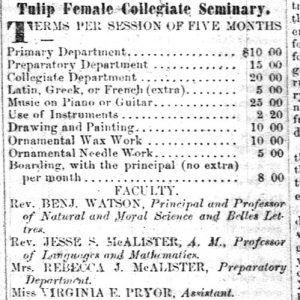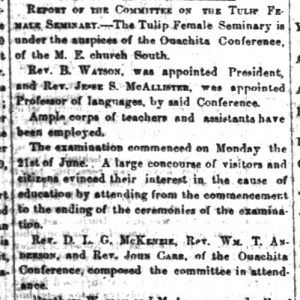calsfoundation@cals.org
Tulip Female Collegiate Seminary
aka: Ouachita Conference Female College
The Tulip Female Collegiate Seminary was established in Tulip (Dallas County) during the antebellum period when the community was flourishing. The school instructed female students in the subjects of the day, such as English and music, in addition to drawing, needle-work, and domestic subjects.
In August 1849, George D. Alexander established the Alexander Institute in Tulip for the education of both girls and boys. In August of 1850, community leaders in Tulip gathered to discuss dividing the Alexander Institute into two schools, one for girls and the other for boys. Among those prominent citizens was the state representative, Major George Clark Eaton, who represented the interests of those wishing to establish the two schools.
On December 17, a legislative charter in the state House of Representatives established the Tulip Female Collegiate Seminary for the young women, requiring that “the said seminary shall be, and forever remain located at or near Tulip, Dallas County, State of Arkansas, and that the estate both real and personal of the said corporation, shall be forever exempt [from] taxes.” The next day, a similar charter was issued establishing the military institute. The board of trustees was given the authority to grant degrees in the arts and sciences and to fund an endowment by the selling of scholarships.
Alexander was appointed as superintendent, and John S. Garven, a native of Georgia, was named principal of the seminary. Garven was replaced a year later by the Reverend Benjamin Watson, a Methodist minister. The school was built within the town of Tulip on land owned by Major Benjamin Borden; he sold the land to the trustees for $100 on April 5, 1852. Some sources also name Borden as being in an unspecified leadership role at the seminary. Borden would eventually house the students at his boarding house nearby.
Albert Pike addressed the combined graduating classes of the Arkansas Military Institute and Tulip Female Collegiate Seminary on June 4, 1852. Pike’s speech was published by William E. Woodruff in Little Rock (Pulaski County) that same year.
In December 1852, another graduation was held. A visitor from Little Rock related that the exams began on Tuesday and included subjects such as natural science, mathematics, classics, and belles lettres, followed on Wednesday by prose and poetry recitations and readings, including essays written by the students. Needlework and embroidery done by the students were also on display. The closing of the examinations included a concert on Wednesday night.
In December 1856, the school was renamed the Ouachita Conference Female College but remained under the direction of Watson. Seven teachers were now employed who instructed the students in science, literature, languages, mathematics, music, and wax work. Also by 1856, the school library had grown sufficiently to draw complimentary reviews from the staff, and the college had added a department for the instruction of teachers. The degree designation MEL was given for students completing study in English and algebra, while an MA was given for completion of the classics course. In the years 1856 to 1858, more than 100 young women from all over Arkansas were said to have attended the college in Tulip.
The final examinations of 1858 were held on June 17–18 for the Arkansas Military Institute and June 21–23 for the Ouachita Conference Female College. The exams, as always, involved both schools and were considered social events for the entire community. The 1858 exams even merited coverage by the Arkansas Gazette. On the last day of exams, a musical concert was performed by students of the Ouachita Conference Female College, followed by speeches by the superintendent and an alumnus of the Arkansas Military Institute, George Wilson Smith. Following the festivities, a scheduled break between terms allowed the students the opportunity to spend time with family and away from study.
Arkansas seceded from the Union on May 6, 1861. The future of both schools was uncertain, but the military institute was the first to end operations, the young men being trained and sent to fight along with many of their male instructors. By the summer of 1861, the military institute was closed. Evidence exists to indicate that the Ouachita Conference Female College was open as late as 1861. No specific date is known for the closure of the school, but it was closed permanently by the end of the war. The Civil War also marked the end of Tulip as a vibrant community. Most of the remaining population fled to Texas or Louisiana, where they remained through the end of the war and beyond.
For additional information:
Brown, Sarah. “Dallas County Multiple Resource Area.” National Register of Historic Places nomination form, 1983. Online at https://npgallery.nps.gov/GetAsset/a71672d8-b647-4f6b-a73b-cbf44aeb418e (accessed November 18, 2022).
Penton, Emily. “Typical Women’s Schools in Arkansas Before the War of 1861–65.” Arkansas Historical Quarterly 4 (Winter 1945): 325–339.
Pike, Albert. An Address Delivered by Albert Pike, Esq., to the Young Ladies of the Tulip Female Seminary, and Cadets of the Arkansas Military Institute: at Tulip on 4th June, 1852. Little Rock, AR: Wm. E. Woodruff, 1852.
Smith, Herschel Kennon, Jr. “Ante-Bellum Schools at Tulip, Arkansas.” Arkansas Historical Quarterly 18 (Autumn 1959): 280–286.
———. “Tulip in Her Glory.” Arkansas Historical Quarterly 17 (Spring 1958): 68–72.
Smith, Jonathan Kennon. The Romance of Tulip Ridge. Baltimore, MD: Deford, 1966.
Michael Hodge
North Little Rock, Arkansas
 Louisiana Purchase through Early Statehood, 1803 through 1860
Louisiana Purchase through Early Statehood, 1803 through 1860 Tulip Female Collegiate Seminary Ad
Tulip Female Collegiate Seminary Ad  Tulip Female Collegiate Seminary Article
Tulip Female Collegiate Seminary Article 



Comments
No comments on this entry yet.